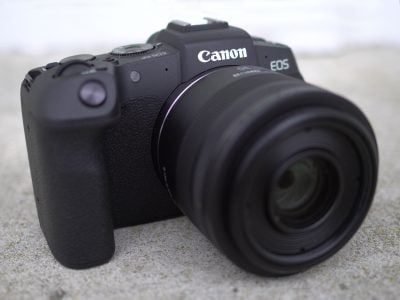Canon EOS RP review
-
-
Written by Gordon Laing
In depth
The Canon EOS RP is an entry-level full-frame mirrorless camera with 26 Megapixels, an electronic viewfinder, fully-articulated touchscreen and cropped 4k video. Announced in February 2019, it’s the second body to employ Canon’s RF lens mount, following the original EOS R. The EOS RP is pitched at a lower-level than the EOS R though, positioned just below the EOS 6D Mark II, making it Canon’s most affordable, not to mention lightest, full-frame body to date. Canon’s aiming it at existing EOS owners with a collection of EF lenses they’d like to continue using, and bundles the RP with an EF lens adapter in most regions.
The EOS RP takes the 26.2 Megapixel full-frame sensor from the EOS 6D Mark II, but makes adjustments to micro-lenses to work better with the shorter flange distance; unlike the EOS R, the sensor remains exposed when you remove lenses, but that’s the same as other mirrorless cameras. The sensor employs Dual Pixel CMOS AF for focusing, with coverage across most of the frame (88% horizontal x 100% vertical) and support for continuous shooting at 4fps with focus or 5fps without. The EOS RP allows focusing at f11, has a new focus bracketing feature (although you’ll need to do the stacking externally), a new spot-focusing mode, and now also supports eye-detection with continuous Servo AF, a feature missing from the EOS R when it was launched. 1080p video is available at 25 to 60p with Dual Pixel autofocus (strangely no 24p), while 4k is limited to 24 or 25p, incurs a crop and uses contrast-based AF only, just like the EOS M50. There’s no built-in stabilisation, so to iron-out any wobbles you’ll need to fit a lens with IS. Movie shooters can however deploy optional digital stabilisation if desired, albeit incurring a crop.
The body is Canon’s smallest and lightest full-frame to date, whether DSLR or mirrorless, measuring 133x85x70mm and weighing 485g including battery – that’s 95g lighter than the EOS R or 200g lighter than the 6D II bodies. Unlike the EOS R, Canon’s gone for a more traditional design on the RP, with a mode dial and no thumb slider. There’s the same 2.36 million dot OLED viewfinder as the EOS M50 with 0.7x magnification, a single SD slot (exploiting UHS-II speeds), and videographers will be pleased to find a side-hinged, fully-articulated 3in touchscreen as well as microphone and headphone jacks – the presence of the latter for monitoring audio is unusual at the price, and there’s also USB charging. If you’d like to increase the height of the body, the EG-E1 grip (bundled in some regions or an optional accessory in others) thickens it up to prevent your pinkie from dangling.
In my in-depth video review, below, I’ll explain and demonstrate all the features, including a comparison of autofocus performance between native and adapted lenses, as well as delving into the photo and movie quality! I’ve taken some excerpts from the video lower on the page as captioned photos if you prefer a non-video approach.
In the absence of a budget kit zoom in the native RF mount at launch, Canon has put together a selection of discounted EF lens bundles in some regions for use with the supplied adapter. The most affordable is the EF 24-105mm STM, although there’s also an EF 24-70mm f4L bundle or one with the smallest and cheapest native lens so far, the RF 35mm f1.8 IS. Once again though, Canon expects the RP to be used, at least initially, with existing EF lenses via the adapter.
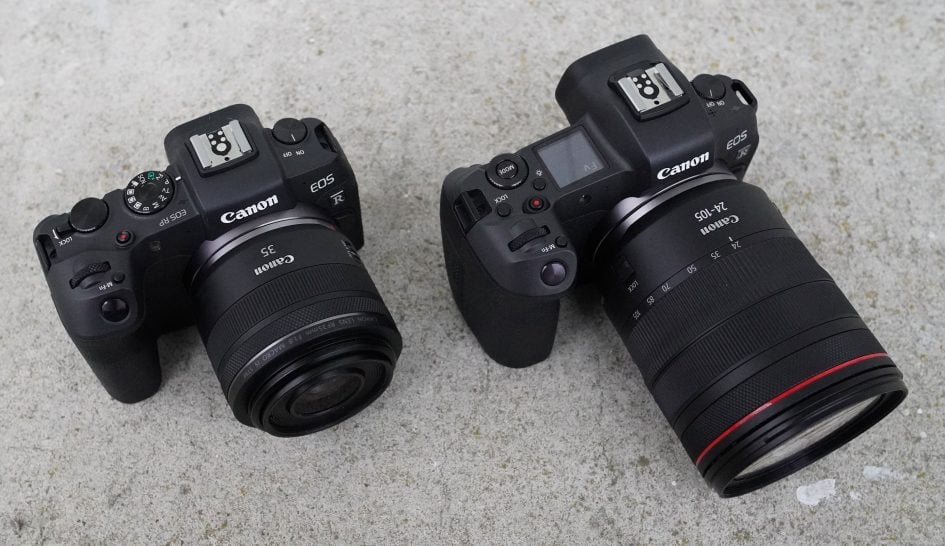
Above: here’s the EOS RP on the left, alongside the original EOS R on the right, and it’s clear the new model is smaller, although I also have it fitted with a shorter lens. The RP is actually Canon’s smallest and lightest full-framer to date, weighing 485g including battery – that’s 175g lighter than the EOS R or 280g lighter than the 6D II bodies when both are fitted with their batteries. In fact it’s only 95g heavier than the tiny EOS M50. The shell’s magnesium alloy and the weather-sealing similar to the 80D, ranking it a little below the EOS R.
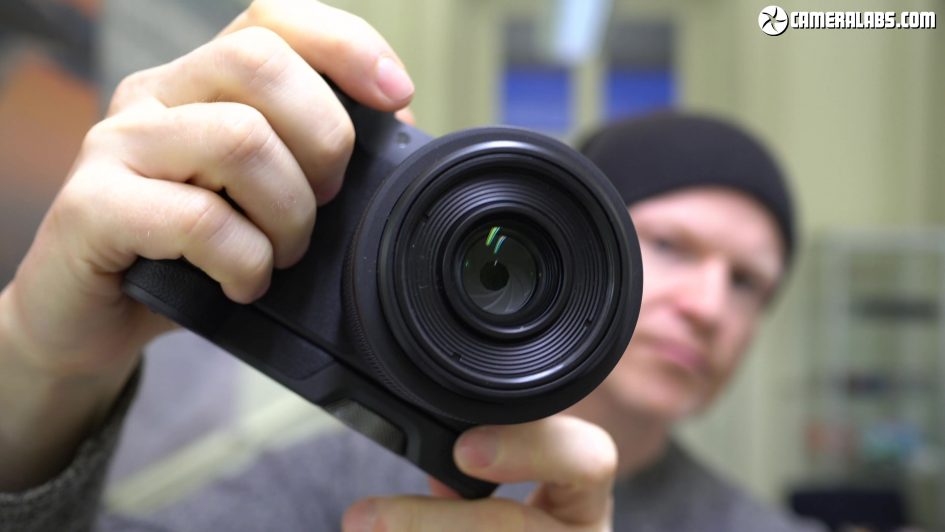
Above: if your pinky’s left dangling and you want more to hold onto, the EG-E1 grip accessory, available in three colours, screws into the base and boosts the overall height while still providing access to the battery and card slot underneath. In some regions it’s an optional accessory, but in others it’s included.
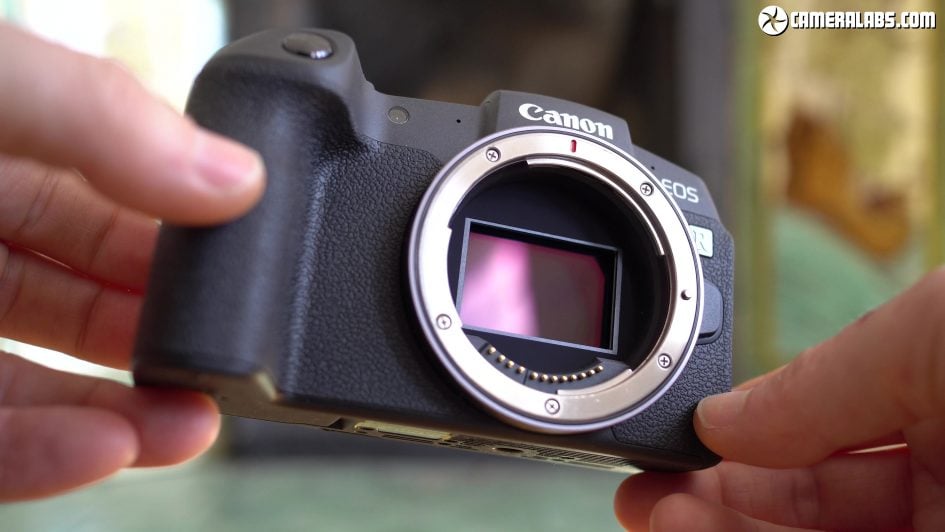
Above: The EOS RP takes the 26.2 Megapixel full-frame sensor from the EOS 6D Mark II, but makes adjustments to micro-lenses to work better with the shorter flange distance of mirrorless. The sensor employs Dual Pixel CMOS AF for focusing, with 88% coverage horizontally and 100% vertically. Sadly but not surprisingly, there’s no built-in stabilisation, so to iron-out any wobbles you’ll need a lens with optical IS. You’ll also notice the shutter’s open, revealing the sensor when lenses are removed. This is the same as most mirrorless cameras, but unlike the EOS R which closed its shutter to shield the sensor from dust. Since the shutter is actually more vulnerable to damage than the sensor though, Canon opted to open it on the RP for its target audience. For comparison, the higher-end EOS R modifies the slightly higher resolution 30 Megapixel sensor from the 5D Mark IV and while it shares the same focus coverage, it can shoot faster bursts and also works in slightly lower light levels. Meanwhile Canon’s RF lens mount is compatible with the four native RF lenses with six more coming in 2019 and will also work with any EF or EF-S DSLR lenses using the adapter.
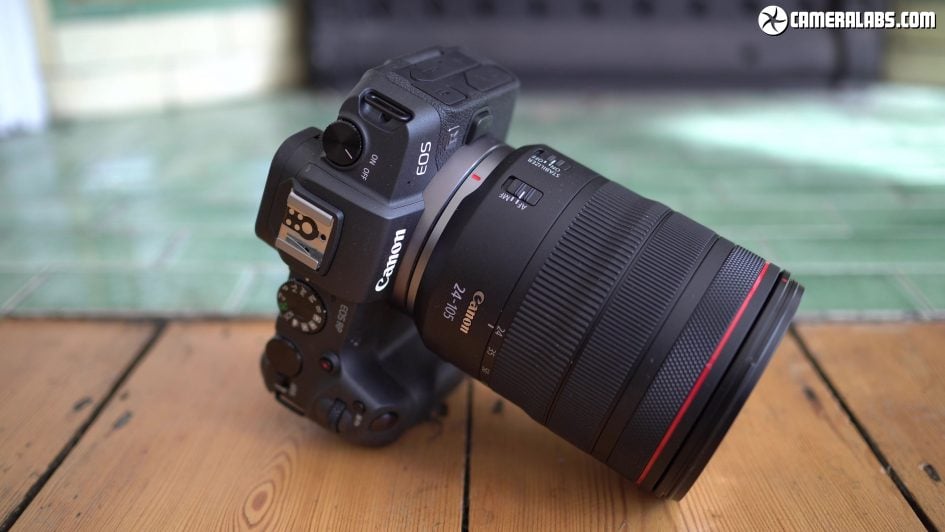
Above: so which lens should you use? Here’s the RP with the RF 24-105mm f4, a great quality general-purpose zoom with the native mount, but one which costs almost the same as the body itself and is arguably too big for it too.
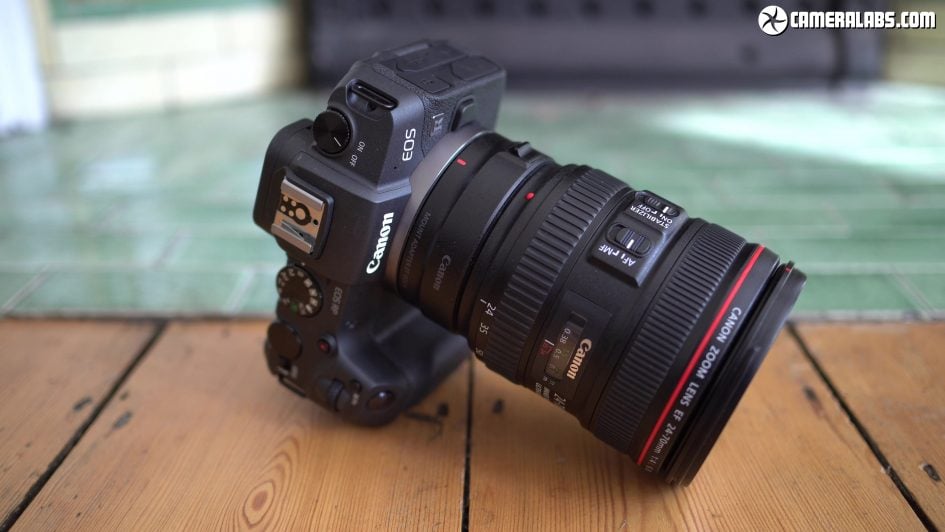
Above: you could of course adapt any EF lens, such as the EF 24-70mm f4L seen fitted here, or perhaps the EF 24-105mm f3.5-5.6 STM at a lower price. In the absence of a budget RF kit zoom, the 24-105mm STM is one of the more affordable options.
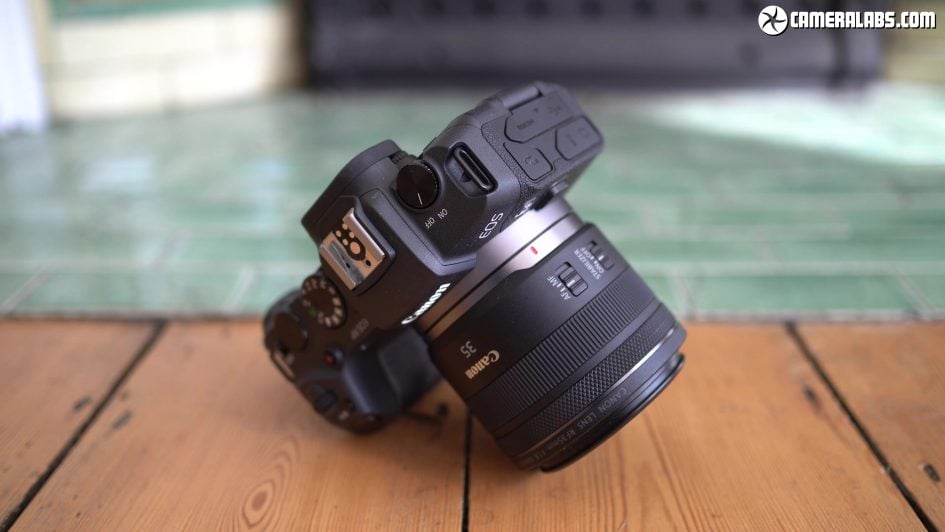
Above: the more I used the RP though, the more fond I became of coupling it with the RF 35mm f1.8, the smallest, lightest and cheapest of the native lenses so far. It doesn’t zoom, but 35mm is a good general-purpose length, the aperture’s bright, it focuses close, and includes optical stabilisation too. It also keeps the overall size and weight down and feels well-balanced. Going forward, the upcoming RF 24-240mm f4-6.3 IS looks like being a great super-zoom for the RP.
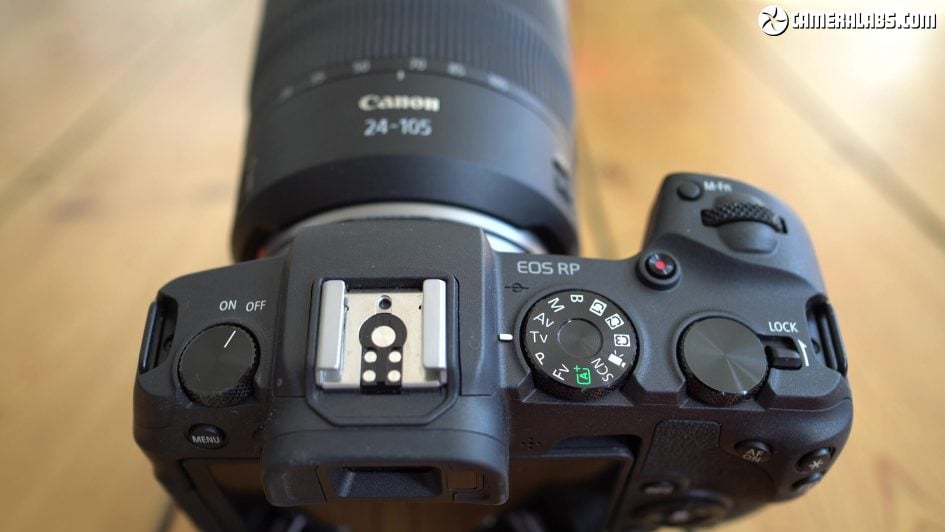
Above: on the top of the camera you have a chunky power dial, a hotshoe for mounting external flashes or accessories, although unlike most rivals at this price, there’s no popup flash built-in. To the right of the viewfinder head, there’s a traditional mode dial which to me makes more sense than the mode button on the EOS R, and it includes three custom banks as well as a B setting that works with Bulb timer menus. There’s also two control dials, one for your finger atop the grip and one for your thumb at the back and that switch can be configured to lock either dial, touch controls, and or the lens ring. There’s also customisable movie and multi function buttons and a soft touch shutter release.
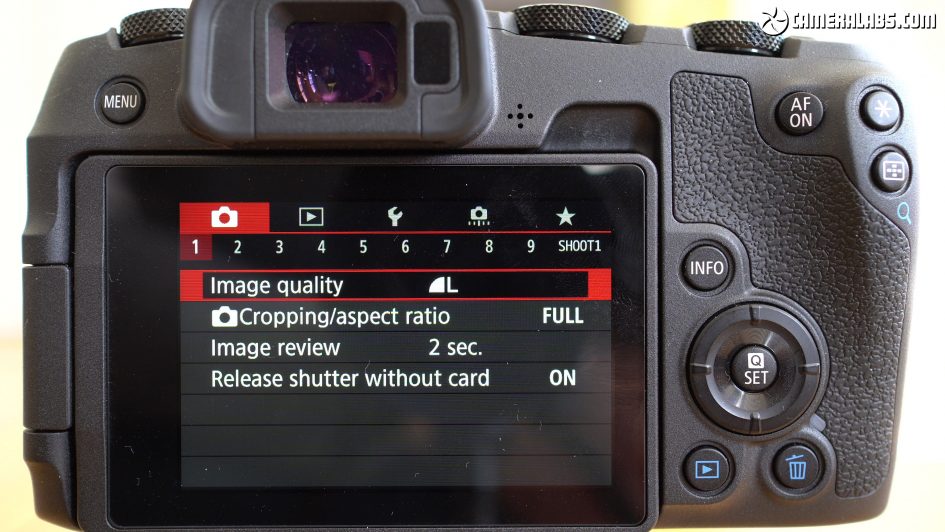
Above: round the back of the camera, there’s the classy inclusion of an AF-On button which can be customised along with the AE lock and AF area buttons alongside it. There’s no dedicated AF joystick but you can use the touchscreen as a touchpad to move the AF area when composing through the viewfinder. And finally in a welcome difference to the original EOS R, Canon’s removed the touchpanel control to the right of the viewfinder. I’m all for innovation but I never felt this control worked that well on the EOS R.
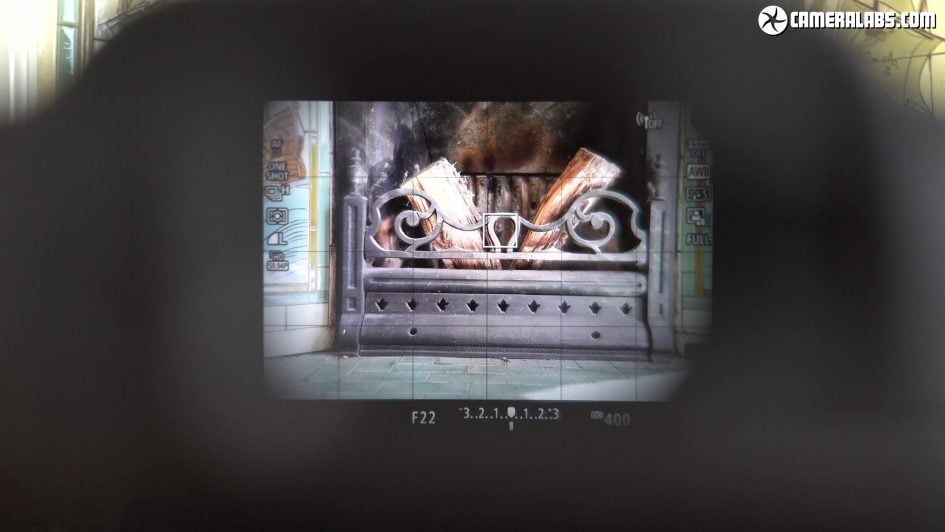
Above: the EOS RP inherits a number of features from the EOS M50, including its electronic viewfinder, a 2.36 million dot OLED panel with 0.7x magnification, coincidentally almost exactly matching the image size of the 6D Mark II’s optical viewfinder, but of course with the ability to overlay wealth of shooting information and guides, playback images, film video, and navigate menus. The original EOS R has a higher resolution viewfinder with a larger magnification too, but the RP’s lower-spec is in line with most rivals at this price point.
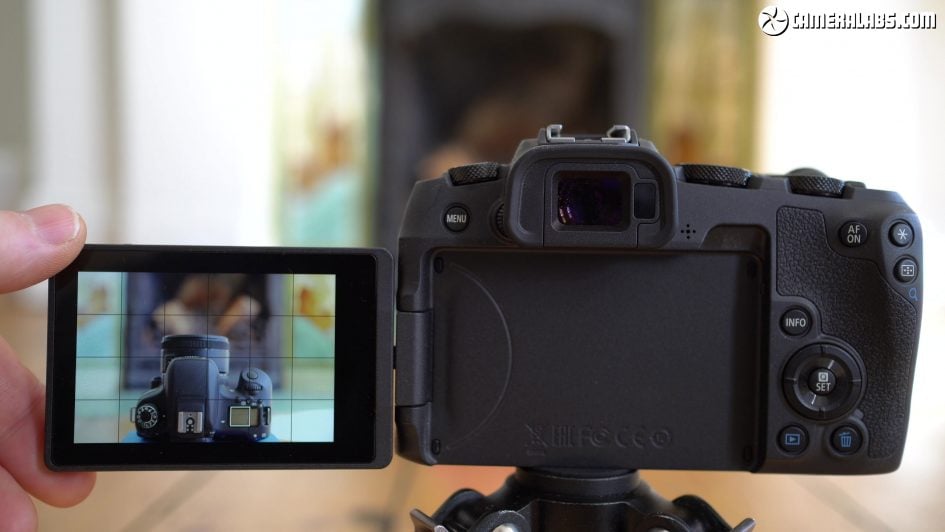
Above: like the EOS R before it, the RP is equipped with a side-hinged, fully-articulated touchscreen that can flip and twist to any position including forward-facing for vlogging or selfies, as well as back on itself for protection. At 3in, it’s a little smaller than the 3.1in screen on the EOS R, but the important part is the articulation which again is so useful whether you’re vlogging or simply composing at high or low angles in the landscape or portrait orientations.
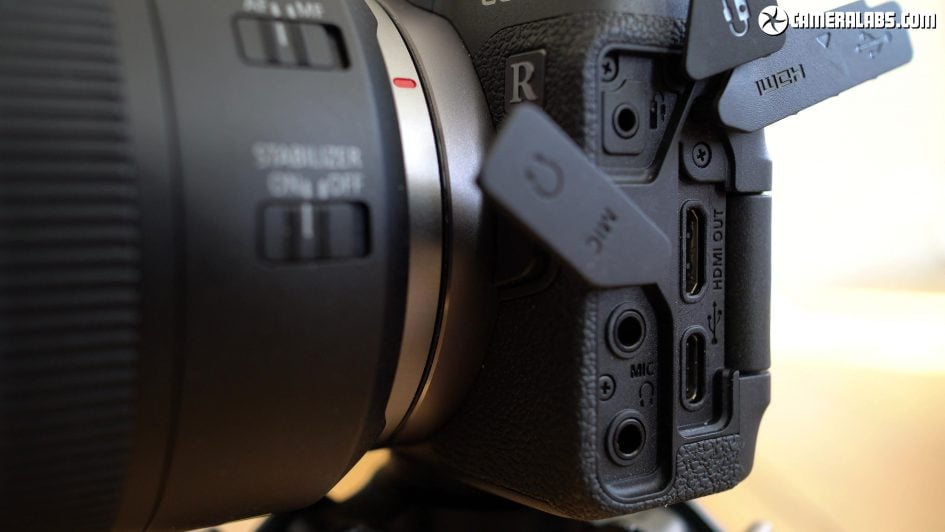
Above: behind three flaps on the side of the body you have an E-3 type terminal for an optional remote cord, a pair of 3.5mm jacks for headphone output and microphone input – nice to see both on a camera at this price point. And finally a Type-C Mini HDMI port which can output 4:2:2 video in 8 bit to external recorders, although be warned when doing so, the screen’s disabled and therefore any manual control over the AF area with it; note the EOS R can output 10-bit over HDMI, but then so can the Fujifilm X-T30. Below the HDMI is a USB C port that can be used to charge the battery inside the camera – I used my MacBook pro 13in charger – although you can’t actually power it over USB for operation unlike the X-T30 or Sony cameras. The USB C port can also of course be used for data transfer, although strangely only at USB 2 speeds rather than 3.1 like most cameras including the EOS R.
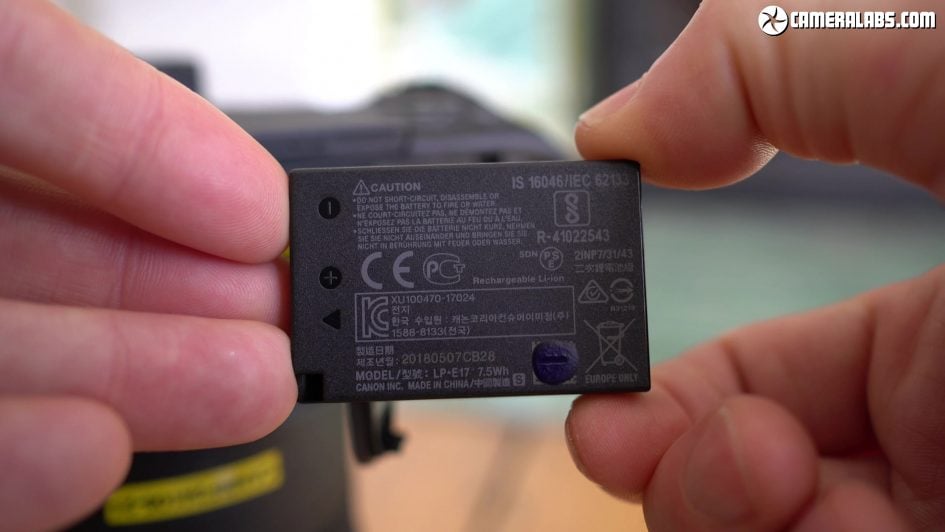
Above: the EOS RP is powered by the LP-17 battery pack, rated for just 250 shots under CIPA conditions, compared to the 370 you’d get from the EOS R powered by the LP-E6. Note the LP-17 is the same as used in the EOS M5, not the M50 as I said in my first-looks video. For pure video use, I managed just over three half hour 1080p clips, giving me almost 100 minutes of recording per charge. Alongside the battery is a single SD card slot supporting UHS-II speeds.
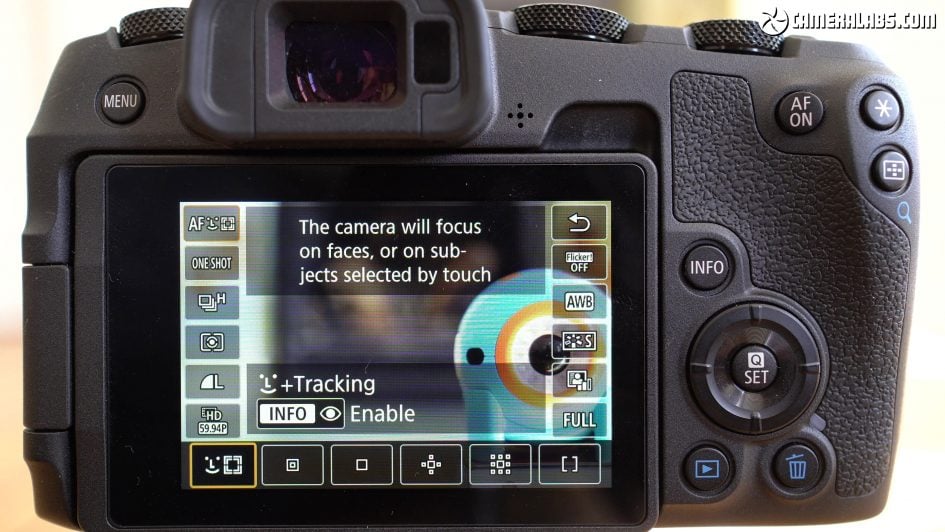
Above: The EOS RP supports a variety of AF area modes including zone, two expand area options, single point, the new smaller spot AF, and face with tracking. Eye detection is now available with continuous Servo AF and in movies, a feature often promoted by Sony but missing from the original EOS R at launch.
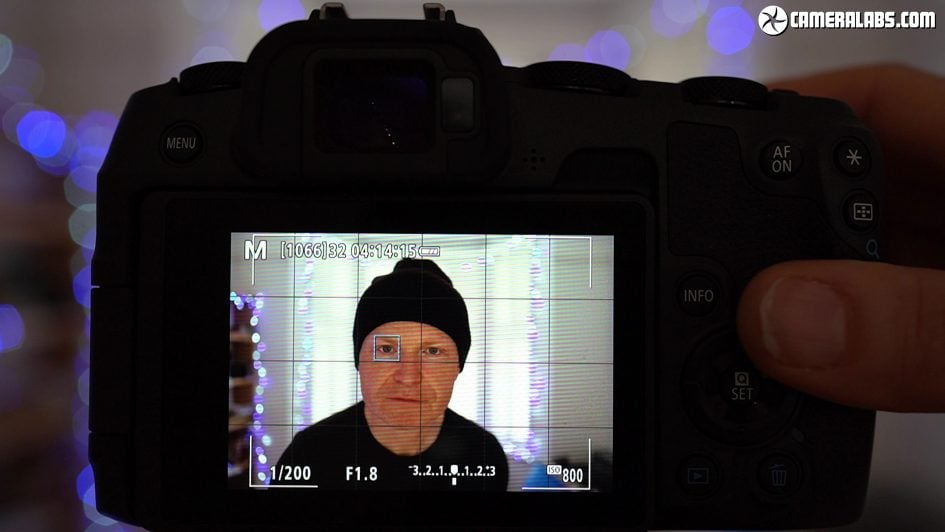
Above: here you can see the face and eye detection in action, and while I needed to be closer to the camera for it to lock onto my face or eye compared to the latest Sonys, it still does a fair job, also switching to normal object tracking when it can’t see my face. Once again eye detection is now available with continuous Servo AF.
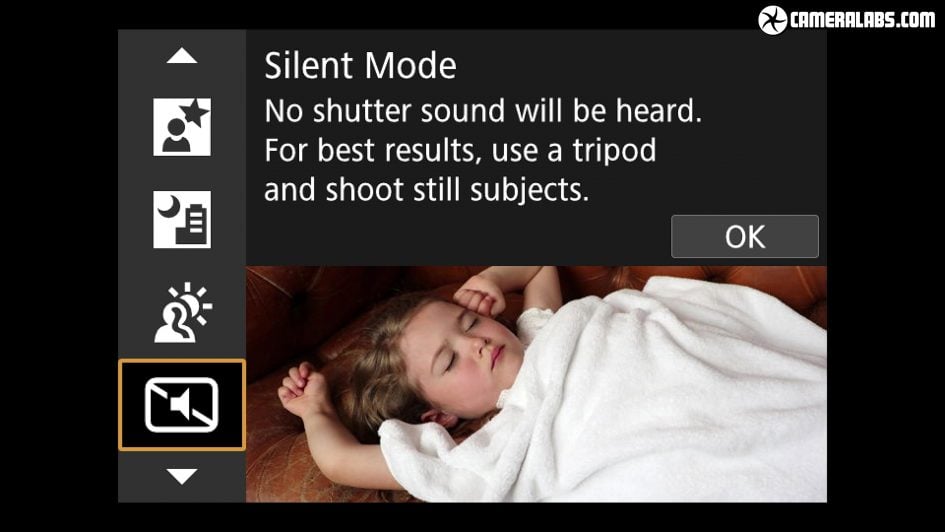
Above: Delve into the Scene presets you’ll find a silent shooting mode, although like all electronic shutters there can be skewing if the subject or camera moves. Just look at the result in the video when I pan with the camera where the radiator and door frame have been rendered into diagonals. Repeating the pan at a much slower speed results in sloping verticals. So use with caution, ideally with static subjects.
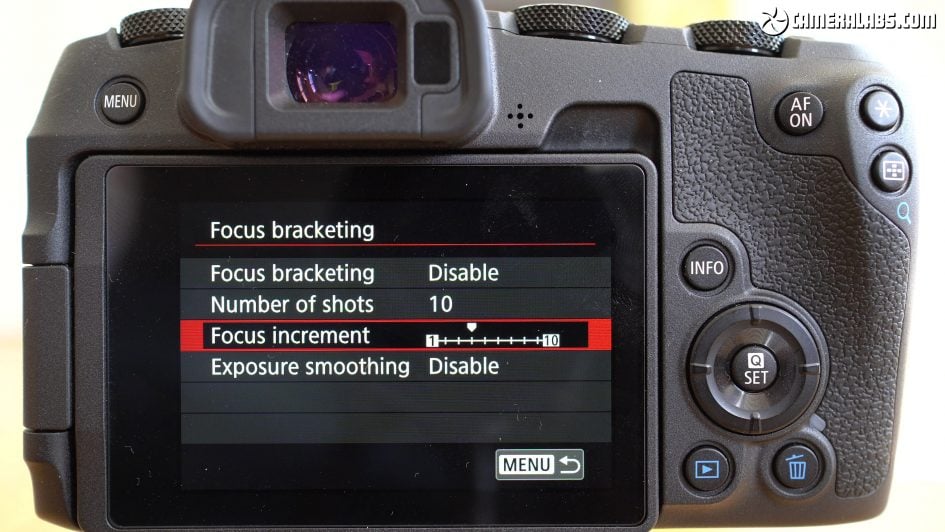
Above: the new focus bracketing mode on the EOS RP. You can use the supplied Digital Photo Professional software to stack the images afterwards.
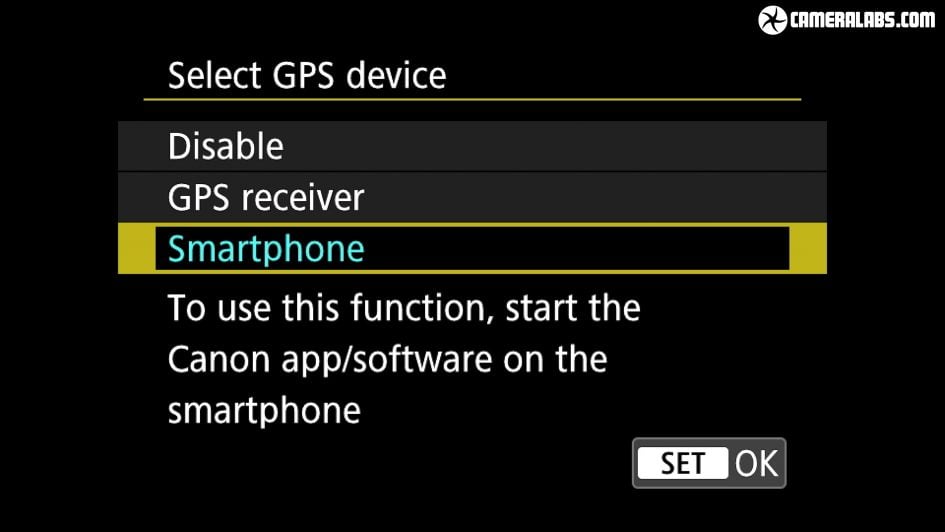
Above: the EOS RP includes Wifi and Bluetooth, the latter providing a quick and responsive remote shutter control on your phone without having to connect over Wifi. The RP can also use Bluetooth to seamlessly receive GPS data from your phone and embed it automatically on your images as you take them if desired. Full remote control of the camera is also possible over Wifi, allowing you to adjust the AF area, exposure and drive mode, or remotely trigger movie recordings.
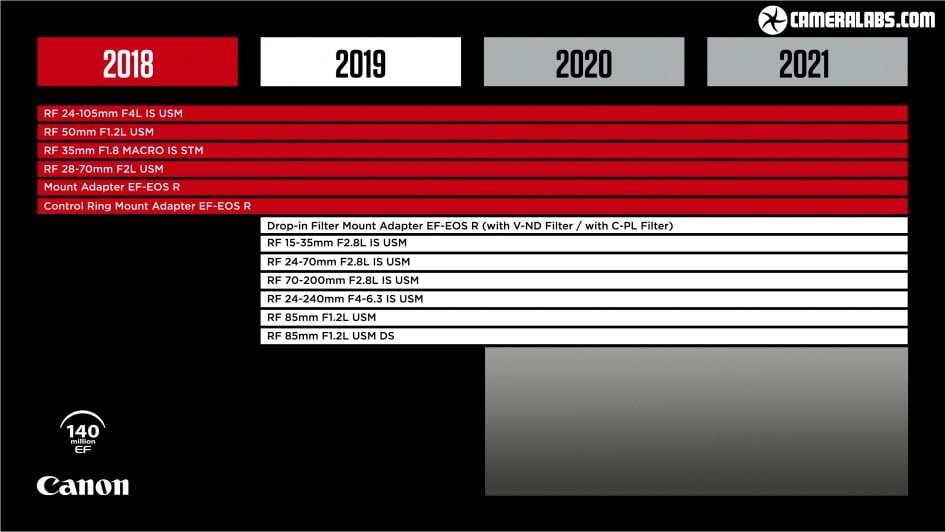
Above: with the launch of the EOS RP, Canon’s updated its RF lens roadmap with six new lenses coming in 2019, joining the existing four from launch. Three of the new models represent the holy-trinity: an ultra wide 15-35mm f2.8L IS, a general-purpose 24-70mm f2.8L IS, a impressively short 70-200mm f2.8L IS, a classic portrait 85mm f1.2L available in normal or defocused DS versions, and a super-zoom 24-240mm f4-6.3 IS. All but the 24-240mm are high-end L lenses, and all but the 85s have optical stabilisation. In the absence of prices at the time I made this video, I’m just guessing the 24-240mm will be the only lower cost option that could become a future kit zoom. But since none are available at the launch of the EOS RP, the new body is being sold alone for use with existing lenses or in a variety of bundles, the most affordable being with the old 6D Mark II kit zoom, the EF 24-105mm STM, working on the RP with an adapter.
Check prices on the Canon EOS RP at Amazon, B&H, Adorama or WEX!
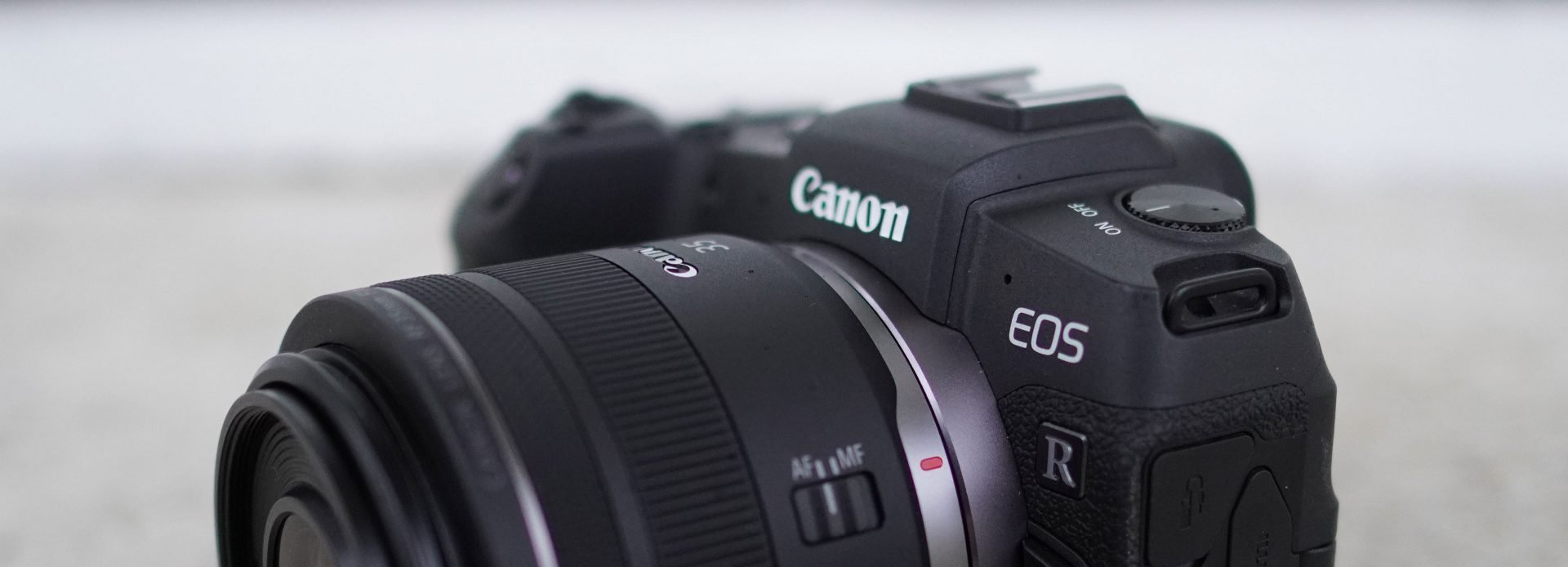
 The Canon EOS RP is the most affordable new full frame camera to date, whether DSLR or mirrorless. It gives you the 26 Megapixel sensor from the 6D Mark II, delivering attractive JPEGs out-of-camera, a fully-articulated touchscreen that’s ideal for vlogging, microphone and headphone jacks, and Canon’s industry-leading dual pixel AF which does a solid job with native RF or adapted EF lenses and delivers effortless 1080 video. On the downside, the battery life is modest, there’s no built-in stabilisation nor twin card slots, and there’s a raft of frustrating video limitations: filming in 4k incurs a tight crop (eliminating the benefit of having a full-frame sensor), and annoyingly loses dual pixel autofocus too. There’s no high-frame rates for slow motion and strangely no 1080 at 24p either. Even weirder, when you fit an EF-S lens, the 1080 options disappear altogether, leaving 720p if you want dual pixel AF or 4k without; indeed this coupled with the reduced photo resolution of 10 Megapixels when adapting EF-S lenses on the RP will reduce its attractiveness for owners of Canon’s APSC DSLRs looking for an upgrade. Then there’s the absence of a low-cost native RF zoom, steering owners to either the fixed RF 35mm, or adapting an older EF lens. If you’re building a new system, the RP also faces stiff competition from the Sony A6400 and Fujifilm X-T30 even with their smaller APSC sensors. I think the EOS RP makes most sense as an upgrade for owners of much older Canon DSLRs, like the original 6D, or perhaps a 5D Mark II, or earlier APSC models like the 70D or even older still. The further back you go, the more you stand to gain from the RP. These owners will enjoy a smooth transition to full-frame mirrorless with decent performance from existing EF lenses and without breaking the bank. It’ll become even more compelling once the RF 24-240mm zoom arrives.
The Canon EOS RP is the most affordable new full frame camera to date, whether DSLR or mirrorless. It gives you the 26 Megapixel sensor from the 6D Mark II, delivering attractive JPEGs out-of-camera, a fully-articulated touchscreen that’s ideal for vlogging, microphone and headphone jacks, and Canon’s industry-leading dual pixel AF which does a solid job with native RF or adapted EF lenses and delivers effortless 1080 video. On the downside, the battery life is modest, there’s no built-in stabilisation nor twin card slots, and there’s a raft of frustrating video limitations: filming in 4k incurs a tight crop (eliminating the benefit of having a full-frame sensor), and annoyingly loses dual pixel autofocus too. There’s no high-frame rates for slow motion and strangely no 1080 at 24p either. Even weirder, when you fit an EF-S lens, the 1080 options disappear altogether, leaving 720p if you want dual pixel AF or 4k without; indeed this coupled with the reduced photo resolution of 10 Megapixels when adapting EF-S lenses on the RP will reduce its attractiveness for owners of Canon’s APSC DSLRs looking for an upgrade. Then there’s the absence of a low-cost native RF zoom, steering owners to either the fixed RF 35mm, or adapting an older EF lens. If you’re building a new system, the RP also faces stiff competition from the Sony A6400 and Fujifilm X-T30 even with their smaller APSC sensors. I think the EOS RP makes most sense as an upgrade for owners of much older Canon DSLRs, like the original 6D, or perhaps a 5D Mark II, or earlier APSC models like the 70D or even older still. The further back you go, the more you stand to gain from the RP. These owners will enjoy a smooth transition to full-frame mirrorless with decent performance from existing EF lenses and without breaking the bank. It’ll become even more compelling once the RF 24-240mm zoom arrives.



